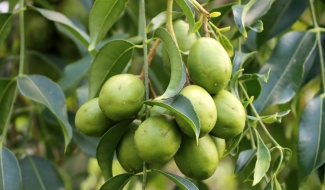History
 Native to Melanesia and Polynesia (Tahiti), the Ambarella or Golden Apple is very common in Southeast Asia. It arrived in the West Indies and tropical America in the 18th century.
Native to Melanesia and Polynesia (Tahiti), the Ambarella or Golden Apple is very common in Southeast Asia. It arrived in the West Indies and tropical America in the 18th century.
Varieties
 No information is provided on the number of varieties of ambarella. Contrary to what one might think ambarella does not belong to the same family of plums but the family of mangoes.
No information is provided on the number of varieties of ambarella. Contrary to what one might think ambarella does not belong to the same family of plums but the family of mangoes.
This beautiful fast-growing ornamental tree can reach 20 meters high. Ambarella trees give rise to clusters of long-stalked oval fruit. They have green skin turning yellow at maturity. Inside, a fibrous core and spiky spine join the juicy pulp.
Health benefits
In Asia, the young leaves and acids, are eaten as a vegetable. Before ripening Ambarella is used against diseases of the liver and stomach ache. Ambarella has properties that affect blood clotting, the contraction of muscles, the strength of bones and teeth on the immune system, on the renewal of tissue, protects against cardiovascular disease, has anti-anemic, anti-stress properties and facilitates intestinal transit.
Uses
 In Asia, crisp and tart green fruit is preserved in vinegar or used as a condiment. In Martinique, it makes a popular herbal green juice taste and low alcohol drink with green fruit, which approximates cider. It can also be used in the design of sorbet.
In Asia, crisp and tart green fruit is preserved in vinegar or used as a condiment. In Martinique, it makes a popular herbal green juice taste and low alcohol drink with green fruit, which approximates cider. It can also be used in the design of sorbet.
The fruit ripe barely is cooked with sugar and then kept unchanged in its syrup or jam. The yellow fruit, soft and musky flavor appreciates fresh.






